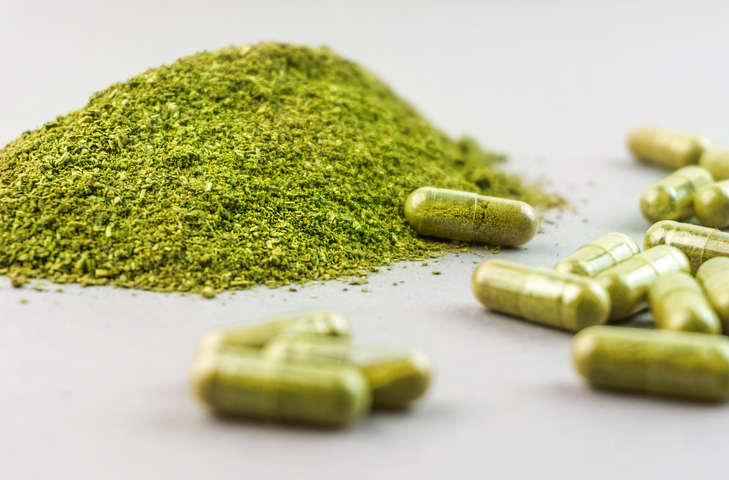In the realm of natural pain management, Kratom has emerged as a popular and intriguing option for many individuals seeking relief from various types of discomfort. This article delves deep into the connection between Kratom and Pain Management, exploring its potential benefits, safety considerations, usage tips, and more. Whether you’re new to Kratom or seeking to enhance your understanding, this comprehensive guide is your roadmap to navigating the landscape of natural pain relief.
Understanding Kratom: A Brief Overview
Kratom, scientifically known as Mitragyna speciosa, is a tropical evergreen tree native to Southeast Asia. Its leaves contain compounds known as alkaloids, particularly mitragynine and 7-hydroxymitragynine, which interact with opioid receptors in the brain to produce a range of effects, including pain relief.
Kratom’s origins trace back centuries in Southeast Asian cultures, where it has been traditionally used for its medicinal properties. Today, Kratom is gaining recognition worldwide for its potential in pain management and beyond. Its unique composition makes it a fascinating subject of study for researchers and a source of hope for individuals seeking alternative remedies for pain.
Exploring the Benefits of Kratom in Pain Management
Kratom is renowned for its analgesic properties, making it a popular choice among individuals seeking relief from chronic pain conditions such as arthritis, fibromyalgia, and migraines. Additionally, Kratom’s mood-enhancing effects can provide a sense of well-being and relaxation, which may complement its pain-relieving benefits.
One of the most significant advantages of Kratom in pain management is its potential to offer relief without the harsh side effects often associated with traditional pharmaceuticals. Many users report experiencing improved quality of life and increased functionality with regular Kratom use. However, it’s essential to explore Kratom’s benefits alongside its potential risks to make informed decisions about its usage.
Different Strains of Kratom for Pain Relief
Kratom is available in various strains, each with its unique blend of alkaloids and effects. When it comes to pain management, certain strains are particularly favored for their potent analgesic properties. Some of the most popular strains include Maeng Da, Bali, and Malay, each offering varying levels of pain relief and duration.
Choosing the right Kratom strain for pain relief can be a personal journey, as individual responses to different strains may vary. While Maeng Da is celebrated for its powerful analgesic effects, Bali Kratom is cherished for its balanced blend of pain relief and relaxation. Exploring different strains under the guidance of experienced users or Kratom specialists can help individuals find the perfect match for their pain management needs.
Dosage Guidelines: How Much Kratom Should You Take for Pain?
Determining the appropriate Kratom dosage for pain management is crucial to maximize its benefits while minimizing the risk of adverse effects. Dosage recommendations vary based on factors such as individual tolerance, Kratom strain, and desired effects. Starting with a low dosage and gradually increasing as needed is a common approach to finding the optimal dose for pain relief.
Finding the right dosage of Kratom for pain management is a delicate balance that often requires patience and experimentation. While there are general guidelines available, such as starting with 2-4 grams for beginners, individual factors play a significant role in determining the ideal dosage. Keeping a dosage journal and being mindful of any changes in effects can help refine the dosage over time.
Methods of Kratom Consumption for Pain Management
Kratom can be consumed in various forms, including powder, capsules, extracts, and teas. Each method of consumption offers its unique advantages in terms of convenience, onset of effects, and duration. Experimenting with different consumption methods allows individuals to customize their Kratom experience based on their preferences and lifestyle.
From traditional brewing methods to convenient capsules, the versatility of Kratom consumption methods caters to a wide range of preferences and needs. Some users enjoy the ritual of preparing Kratom tea, while others prefer the convenience of pre-measured capsules for on-the-go relief. Exploring different consumption methods adds an element of personalization to the Kratom experience, enhancing its appeal as a natural pain management solution.
Potential Side Effects and Safety Concerns
While Kratom offers promising benefits in pain management, it’s essential to be aware of potential side effects and safety considerations. Common side effects may include nausea, dizziness, constipation, and headache, particularly at higher doses. Additionally, prolonged or excessive Kratom use may lead to dependency and withdrawal symptoms in some individuals.
Understanding the potential side effects and safety concerns associated with Kratom empowers users to make informed decisions about its usage. While Kratom is generally well-tolerated when used responsibly, it’s crucial to approach it with caution, especially for individuals with pre-existing health conditions or those taking medications. Consulting with a healthcare professional before incorporating Kratom into your pain management regimen is advisable to ensure safety and efficacy.
Combining Kratom with Other Pain Management Strategies
Integrating Kratom into a holistic pain management approach can enhance its effectiveness and complement other strategies such as exercise, mindfulness practices, and dietary modifications. By combining Kratom with lifestyle changes and alternative therapies, individuals can optimize their pain relief efforts and improve overall well-being.
Kratom’s versatility allows it to seamlessly integrate into various pain management strategies, offering a multifaceted approach to addressing discomfort. Whether used alongside physical therapy exercises or as part of a mindfulness routine, Kratom can enhance the overall efficacy of pain management efforts. By adopting a comprehensive approach that combines Kratom with other strategies, individuals can unlock synergistic benefits
Kratom Legality: Is it Legal and Safe to Use for Pain Management?
The legal status of Kratom varies by region, with some countries and states placing restrictions or outright bans on its sale and consumption. While Kratom remains legal in many areas, it’s essential for individuals to research and understand the regulations governing its use in their specific location. Additionally, ensuring the purchase of high-quality, lab-tested Kratom from reputable vendors is crucial for safety and efficacy.
Navigating the legal landscape surrounding Kratom can be complex, as regulations continue to evolve in response to changing perceptions and research findings. Despite its legal status, safety remains a primary concern for users, emphasizing the importance of sourcing Kratom from trusted suppliers who adhere to rigorous quality standards. By staying informed and exercising caution, individuals can safely incorporate Kratom into their pain management regimen while complying with relevant regulations.
Personal Experiences: Stories of Using Kratom for Pain Relief
The firsthand experiences of individuals using Kratom for pain relief offer valuable insights into its effectiveness and potential benefits. By sharing personal anecdotes and testimonials, users contribute to a collective understanding of Kratom’s role in managing various types of pain and improving overall quality of life.
Listening to the experiences of others who have incorporated Kratom into their pain management routine provides a nuanced perspective on its efficacy and versatility. From individuals overcoming chronic pain conditions to those seeking relief from acute discomfort, personal stories shed light on the diverse ways in which Kratom can positively impact lives. By sharing their journeys, users foster a supportive community and inspire others to explore Kratom as a natural solution for pain relief.
Addressing Common Misconceptions About Kratom and Pain Management
Despite its growing popularity, Kratom is often surrounded by misconceptions and misinformation. Addressing common myths and clarifying misconceptions fosters a more accurate understanding of Kratom’s potential benefits and risks in the context of pain management.
Dispelling myths and misconceptions surrounding Kratom is essential for promoting informed decision-making and safe usage practices. From misconceptions about its addictive potential to unfounded claims about its safety, addressing misinformation empowers individuals to approach Kratom with a balanced perspective. By fostering open dialogue and providing accurate information, misconceptions can be debunked, allowing individuals to make well-informed choices about incorporating Kratom into their pain management regimen.
Tips for Purchasing High-Quality Kratom
When purchasing Kratom for pain management, prioritizing quality and purity is paramount to ensure safety and efficacy. By following these tips, individuals can make informed decisions and source high-quality Kratom from reputable vendors.
Choosing the right Kratom supplier is crucial for obtaining a safe and effective product. Look for vendors who prioritize transparency and quality control measures, such as lab testing for purity and potency. Additionally, read reviews and testimonials from other users to gauge the vendor’s reputation and customer satisfaction. By investing in high-quality Kratom from trusted sources, individuals can experience the full potential of this natural remedy for pain relief.
Understanding the Science Behind Kratom’s Pain-Relieving Properties
The mechanisms underlying Kratom’s pain-relieving effects are a subject of ongoing research and scientific inquiry. By exploring the pharmacology and biochemistry of Kratom’s active compounds, researchers aim to unravel the mechanisms through which it exerts its analgesic effects.
The scientific exploration of Kratom’s pain-relieving properties is a fascinating area of study that continues to yield valuable insights. Researchers have identified specific alkaloids within Kratom, such as mitragynine and 7-hydroxymitragynine, that interact with opioid receptors in the brain, leading to pain relief. Understanding the intricate biochemical pathways involved in Kratom’s effects paves the way for the development of targeted therapies and further enhances our understanding of its potential in pain management.
Kratom vs. Traditional Pain Management Methods: A Comparative Analysis
Comparing Kratom to traditional pain management methods offers valuable insights into its efficacy, safety, and overall impact on quality of life. By examining key factors such as effectiveness, side effects, and accessibility, individuals can make informed decisions about incorporating Kratom into their pain management regimen.
Contrasting Kratom with traditional pain management methods provides a holistic perspective on the benefits and limitations of each approach. While pharmaceutical medications offer targeted relief, they may also be accompanied by significant side effects and risks of dependency. In contrast, Kratom offers a natural alternative with the potential for effective pain relief and fewer adverse effects. By weighing the pros and cons of each option, individuals can make personalized choices that align with their unique needs and preferences.
Exploring Kratom’s Impact on Mental Health and Pain Management
In addition to its physical effects, Kratom’s influence on mental health and well-being is a subject of interest among researchers and users alike. By exploring the relationship between Kratom use and mental health outcomes, we can gain a comprehensive understanding of its holistic impact on pain management.
Beyond its analgesic properties, Kratom has been reported to exert positive effects on mental health, including mood enhancement and stress reduction. Many users report experiencing improved mood, reduced anxiety, and enhanced overall well-being with regular Kratom use. While further research is needed to fully understand the mechanisms underlying these effects, anecdotal evidence suggests that Kratom may offer holistic benefits for both physical and mental health.





